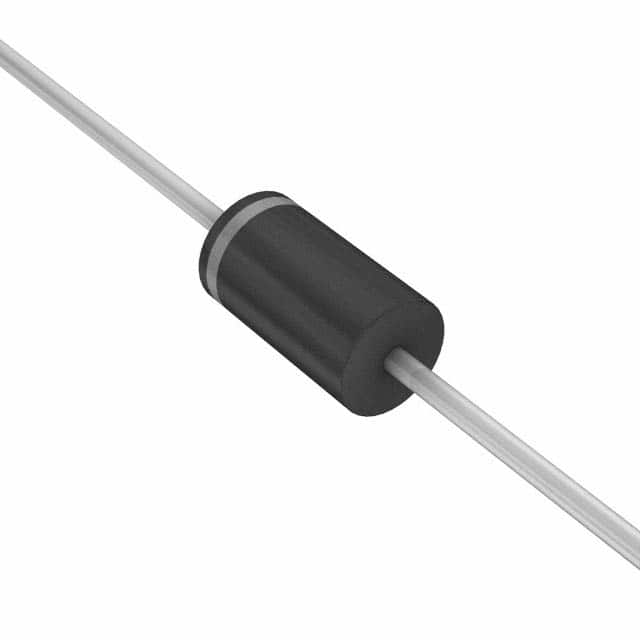1.5KE170AHE3/51 - Product Encyclopedia Entry
Introduction
The 1.5KE170AHE3/51 is a high-performance TVS (Transient Voltage Suppressor) diode designed to protect sensitive electronics from voltage transients induced by lightning, electrostatic discharge (ESD), and other transient voltage events. This entry provides an overview of the product, including its category, use, characteristics, package, specifications, pin configuration, functional features, advantages, disadvantages, working principles, application field plans, and alternative models.
Basic Information Overview
- Category: Electronic Components
- Use: Voltage Transient Protection
- Characteristics: High Surge Capability, Fast Response Time
- Package: DO-201AD (DO-27)
- Essence: Protects Sensitive Electronics from Voltage Transients
- Packaging/Quantity: Tape & Reel, 500 units per reel
Specifications
- Peak Pulse Power: 1500W
- Standoff Voltage: 144V
- Breakdown Voltage: 160V
- Clamping Voltage: 231V
- Peak Pulse Current: 9.2A
- Operating Temperature Range: -55°C to +175°C
Detailed Pin Configuration
The 1.5KE170AHE3/51 TVS diode has a standard DO-201AD package with two leads. The pin configuration is as follows: - Pin 1: Anode - Pin 2: Cathode
Functional Features
- Fast response time to transient voltage events
- High surge capability for reliable protection
- Low clamping voltage to minimize stress on protected circuits
Advantages and Disadvantages
Advantages
- Robust protection against voltage transients
- Wide operating temperature range
- Compact and easy-to-use package
Disadvantages
- Higher clamping voltage compared to some alternative models
- Limited to unidirectional protection
Working Principles
The 1.5KE170AHE3/51 operates based on the principle of avalanche breakdown. When a transient voltage event occurs, the diode rapidly conducts, diverting the excess energy away from the protected circuit. This action helps to limit the voltage across the circuit to a safe level, preventing damage to sensitive components.
Detailed Application Field Plans
The 1.5KE170AHE3/51 is commonly used in various applications requiring protection against voltage transients, including: - Power Supplies - Communication Equipment - Industrial Control Systems - Automotive Electronics - Consumer Electronics
Detailed and Complete Alternative Models
Some alternative models to the 1.5KE170AHE3/51 include: - P6KE170A - SMBJ170CA - 1.5SMC170A
In summary, the 1.5KE170AHE3/51 TVS diode offers robust protection against voltage transients in a compact and reliable package. Its fast response time and high surge capability make it suitable for a wide range of applications, although users should consider its clamping voltage and unidirectional nature when selecting a protection solution.
Word Count: 410
قم بإدراج 10 أسئلة وإجابات شائعة تتعلق بتطبيق 1.5KE170AHE3/51 في الحلول التقنية
What is the 1.5KE170AHE3/51 used for?
- The 1.5KE170AHE3/51 is a transient voltage suppressor diode designed to protect electronic circuits from voltage spikes and transients.
What is the maximum peak pulse power of the 1.5KE170AHE3/51?
- The maximum peak pulse power is 1500W for a 10/1000μs waveform.
What is the breakdown voltage of the 1.5KE170AHE3/51?
- The breakdown voltage is 170V.
What are the typical applications for the 1.5KE170AHE3/51?
- Typical applications include protection of sensitive semiconductor devices, such as integrated circuits, transistors, and diodes, from overvoltage events.
What is the operating temperature range of the 1.5KE170AHE3/51?
- The operating temperature range is -55°C to +175°C.
How does the 1.5KE170AHE3/51 provide protection?
- It clamps the voltage across the protected circuit when subjected to transient overvoltage conditions, diverting excess current away from the sensitive components.
Is the 1.5KE170AHE3/51 suitable for automotive applications?
- Yes, it is suitable for automotive electronics protection due to its high surge capability and reliability.
Can the 1.5KE170AHE3/51 be used in telecommunications equipment?
- Yes, it is commonly used in telecommunications equipment to protect against lightning-induced surges and other voltage transients.
What is the response time of the 1.5KE170AHE3/51?
- The response time is very fast, typically in the nanosecond range, providing rapid protection against voltage spikes.
Does the 1.5KE170AHE3/51 require any external components for proper operation?
- It can be used standalone, but additional circuitry such as fuses and capacitors may be added for enhanced protection and performance.


